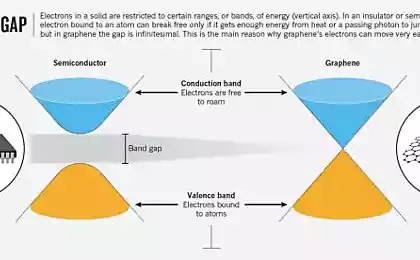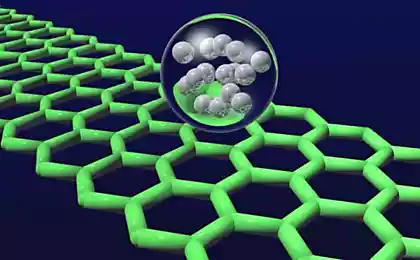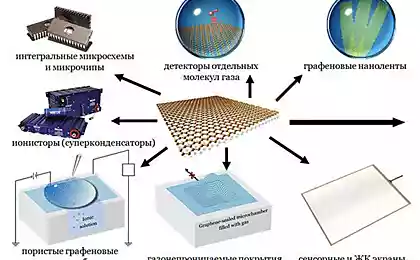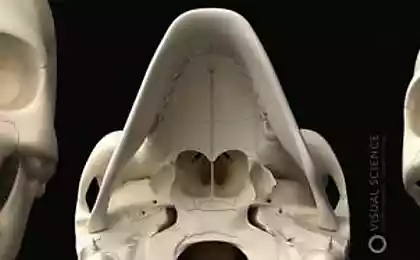3217
Graphene - a life or death?

By the end of 2013 were published two remarkable articles. One is dedicated to the creation of the resonator or reference oscillator based on graphene, and the second - Review of the present and the future of graphene. So what are waiting for graphene in the future - life and flourishing carbon electronics or death and oblivion?
mechanical oscillator based on graphene h4>
Transition to a fully carbon electronics require the creation of not only transistors, resistors and capacitors, but also oscillators and resonators that convert direct current into a periodic signal. They provide so-called "clocking" or reference frequency chips, as well as responsible for the timing in telecommunications. Accordingly, without this small device can not imagine any flash memory , no mobile phone, no modern TV.
The most accurate resonators are based on wafers cut from monocrystalline quartz along specific planes , and if accuracy is not so important, then they are replaced resonators based ceramics, for example, PZT . However, to the great regret of all the engineers of the world, this piece is almost a major stumbling block in the way of reducing the size of electronic devices.
And here come to the aid of nano- and micro-electromechanical devices ( NEMS and MEMS ), an ideology which scientists from Columbia University in collaboration with colleagues from Korea used in the development of graphene NEMS resonator. But not simple, but more and able to rebuild the operating frequency in the range of 14%, when the applied voltage.

a. A simplified diagram of a resonator (inset SEM-micrograph of the device). b. Transmission spectrum for an open circuit (S 21 sub>): amplitude (green) and phase (red). c. The output power spectrum created graphene resonator i>
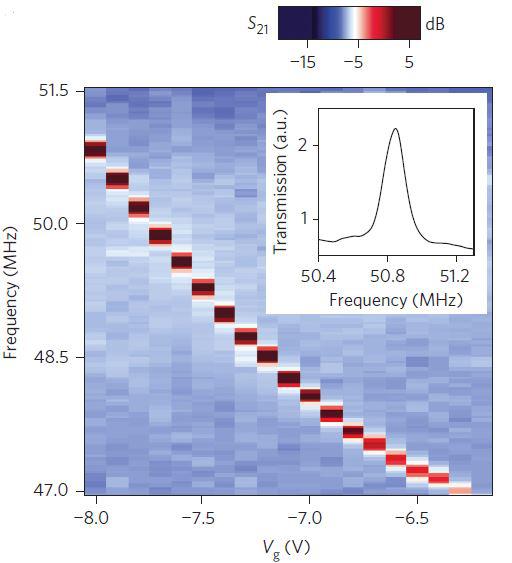
The change in frequency of the resonator when changing V g sub> i>
And as proof of the practical significance of his invention researchers collected a small FM-radio, using the above-described graphene oscillator, and then received and decoded signal infamous song PSY (Koreans, that they take something ?!). Listen to gain entry, please visit Nature or download the here .

The radio station based on graphene. a. The electrical circuit. b, and c - transmitted and received signals, respectively, i>
The article was published in the journal Nature Nanotechnology November 17, 2013.
What is the future of graphene? H4>
Impressive article - definitely yes. After all, since the opening of this wonderful material and decades had passed, and created processor and resonator , capacity based on different carbon materials . Silicon learn to type on polymers. And now it seems that happiness is. There are challenging projects , who receive prestigious design awards Red Dot Design Awards Winner drives for stickers of graphene. A in Europe went crazy with the mere mention of these magical letters - graphene.
A similar situation was in science commercials years ago 30 when she was discovered and proved высокотемпературная superconductivity . It might seem a little bit more, to find the right composition, and here it is, the problems of humanity in terms of the transmission of electricity for millennia. Tens of thousands of scientists switched on a quest ever oxide compounds, millions of dollars, marks and francs (yes, the euro, and then still did not exist) poured on scientists, but ...
The reality turned out to be more severe, and little progress has happened, everything came to a halt at temperatures order of 180-190 K and then pressurized . Although, in fairness, it should be noted that at CERN superconducting magnets used in many hospitals conducted magnetic resonance tomography, even train began to fly, levitating , but I think that this is only a small part of dreamed about people working with superconductors.
At the end of 2013 launched the European mega-project - Graphene Flagship , within which planned to spend 1 billion euros only "state" funds for 10 years, and yet still be private investment. And yes, Nokia and many European giants in too!
But whether this project will be the same race scientific vanity, as happened three decades ago with superconductivity? B> i>
In this regard, I am very impressed Review written by Marc Ash (Mark Peplow) and published in the Nature < / a> just a couple of days after the article about graphene resonator.
Let summarize its essence. Graphene - great stuff. On the one hand it is elastic, ie bends. Collapsed into a tube graphene - carbon nanotube, the diameter of which may range from 1.5 nm to hundreds of nm. In this case, the column "strong" as Superman and industrious as an ant, it is able to withstand the tremendous load (rated tensile strength of about 1000 GPa).
Graphene on the one hand has virtually zero запрещённую zone and very light, electrons and holes, which makes it a perfect conductor, capable of conducting signals faster than any other material on the planet, but it is also its main disadvantage. How to stop the current? After all the electronics works on the principle on / off (current flows / current is blocked). That is, it is necessary to artificially create this same band gap, or to change the paradigm: instead of on / off electronics is electronics, control voltage, or in other words, a kind of analogue analog electronics (pardon the pun).

On the other hand it is transparent, that is ideal as a replacement of ITO in modern displays. However, two-dimensional systems by themselves are not stable, so the problem of creating perfectly smooth graphene coating on any surface - Heavy scientific and technical challenge.
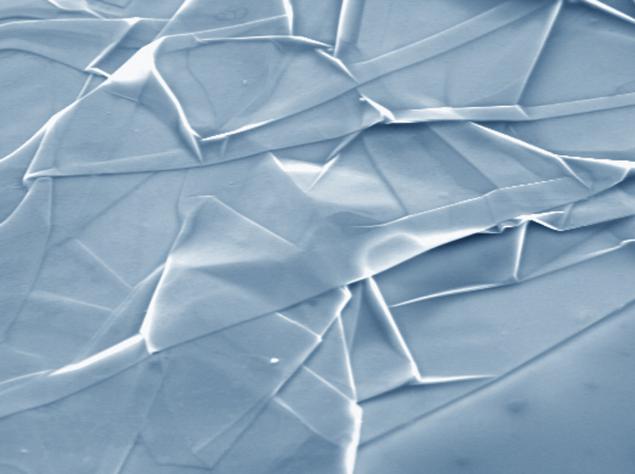
The folds of graphene. Источник
And it turns out that while graphene, though seems a superman with a large letter G instead of S, we can not implement it in production due to the Joker, hiding behind his back. In support of this, the author gives the following statement Review Tim Harper (Tim Harper) from the company Cientifica , introducing new technologies, "No one will just so ruin silicon, unless there is really a compelling reason to do so. " This means that as the resource of silicon as a platform for the creation of microelectronic devices will not be developed by more than 146%, we do not see the transition to the era of carbon.
That is why the first stage of the program will be implemented aimed at finding and creating prototypes of devices based on graphene, which, apparently, be sure to include a resonators described above, various sensors (and in fact even the sensor magnetic fields was based on graphene ).
Well, we are now living in an era of great things that can radically change our lives! Let's see what we will present 2014.
PS: Successful New Year Habrovchane!
Source: habrahabr.ru/post/208286/
Flashmob 2014
Part 2. How many Mbit / s can be passed through the optic nerve and the retina at a resolution? Some theory

















